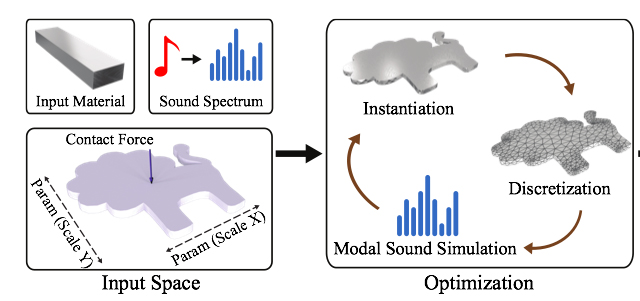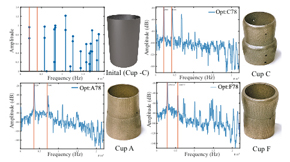When struck, objects vibrate, producing sound. While we can hear sounds, vibrations go mostly unnoticed until they become disruptive, interfering with the smooth operation of motors and engines or shortening the life of bridges, high-rises, and other structures susceptible to environmental vibrations. In a step toward controlling vibrations, a team of researchers has created an algorithm that automatically optimizes the shape of 2D and 3D objects to control the frequencies and amplitudes of the sounds generated when those objects vibrate after being struck. To prove the concept, the researchers created a zoolophone, a xylophone-type instrument with metal animal-shaped keys. By leveraging 3D printing to achieve the necessary customization, the researchers were able to exactly control the acoustics of each key and match the tones of a professionally produced instrument. The zoolophone hints at the possibilities of designing objects with user-specified acoustic characteristics.
Unwanted vibrations are the bane of engineers, who go to great lengths to reduce or eliminate them from engines, motors, and other mechanical devices and to design structures to not amplify environmental vibrations. Controlling vibrations will lead to more structurally sound bridges and high rises, more efficient motors, and even quieter computer fans.
In
Computational Design of Metallophone Contact Sounds, a paper presented this month at SIGGRAPH Asia, researchers show that it’s possible to use computational methods to actively control acoustic properties—both sound and vibration—by altering the shape of 2D and 3D objects and doing so in a fully automatic way.
To demonstrate the principle, a team of seven researchers designed and 3D-printed a zoolophone—a metallophone with keys in the shape of zoo animals. (A metallophone is similar to a xylophone but with metal keys.) Each zoo-animal key is perfectly tuned to play a note in the C Major scale (C, D, E, F, G, A, B, and C), complete with overtones that contribute to the sound’s timbre. Creating such an instrument would be very difficult using traditional methods that rely on trial and error.
The zoolophone is an original and fun musical instrument, but it also represents fundamental research into understanding the complex relationships between an object’s 2D or 3D geometry and its material properties, and the vibrations and sounds it produces when struck. It is the same acoustic territory staked out by physicist Mark Kac in 1966 when he famously asked, Is it possible to work backwards from the sound of a drum to figure out the geometric shape of the drum that produced it?
While the answer to that question is No (though one can tell a drum’s circumference and area), the zoolophone project answers Yes to a slightly different question: is it possible to start with a sound and then find a shape that can produce it, and do so in a fully automatic way? Answering it took seven researchers nearly two years to overcome new challenges in optimization and parameterization as well as in fabricating metal 2D and 3D objects.
The team was led by
Changxi Zheng, whose previous work in computer graphics includes synthesizing realistic sounds that are automatically synchronized to simulated motions. The zoolophone project builds on this previous work while leveraging concepts from acoustic modeling, physics, mechanical engineering, and 3D printing.
Finding the right shape for the right sound
While previous algorithms attempted to optimize either amplitude (loudness) or frequency, the zoolophone required optimizing both simultaneously. Creating realistic and pleasing musical sounds also required adding overtones, secondary frequencies higher than the main one and that contribute to the timber associated with notes played by a professionally produced instrument. A note by itself (a single frequency) would sound dull and plain otherwise.
The end-to-end method works like this: the user specifies a shape (in this case, a zoo animal) and the desired sound as well as a contact spot where the shape is to be struck. From this input, researchers construct variations of the zoo animal (in mesh form); if the desired animal is a lion, every conceivable shape and configuration of a lion is considered: tall lions, short lions, lions with a very long tail and others with a normal-length tail, and some others with every tail length in between.
It’s an immense search space, and searching it for the most optimal shape that, when struck, produces the wanted sound, proved to be the core computational difficulty.
While there are a number of different optimization algorithms for intelligently searching and sampling from within a large space, existing ones proved too slow and too apt to fall into a local minima (that is, the algorithm converges on the most optimal value within a subarea of the entire search space without having explored the entire space for an even more optimal one).
To increase the chances of finding the most optimal shape and doing so quickly, Zheng and his colleagues proposed a new and fast stochastic optimization method, Latin Complement Sampling. This new method ensures samples are taken evenly from across a particular subarea of the entire search space, while using the information learned from the previous search to ensure that the unexplored subareas most likely to contain optimal values are not neglected. Latin Complement Sampling outperformed all other alternative optimizations, and could be used in a variety of other problems.
A second task was to accurately predict the sound each shape will produce when struck. However, much of this work had already been done. In
Toward High-Quality Modal Contact Sound, Zheng and Doug James describe a method for simulating a sound, given a shape and material. The current zoolophone project adapts this work by inverting it: given a sound, what shape can produce it.
The optimal shape, once found, is then perforated—again in an automatic way—to suppress unwanted overtones, keeping only those that enhance the sound.
New original musical instruments become possible
Creating animal or other specially shaped keys would be prohibitively difficult and time-consuming using traditional manual methods. Connecting sound characteristics with an object’s shape is not intuitive, and manual methods “work” by starting with a shape whose acoustics are somewhat understood—almost always the familiar rectangular shape—and then tweaking it by carving out dimples (hidden on the backside) until the desired sound is achieved. It’s laborious work and it requires expertise.
In contrast the zoolophone’s method computes the shape, performs the necessary perforations (which do the same work as the dimples), and simulates the sound that will result. Designers thus know beforehand exactly what sounds will be produced before an object is fabricated. What was once vague becomes entirely predictable and controllable, and because the process is fully automated, no previous acoustic or music knowledge is required. Even novices can design their own original musical instruments.
With the advent of 3D printing, it’s now relatively easy and affordable to fabricate those designs. Essential to building the zoolophone is the ability to exactly control the shape and geometry of each animal-shaped key, something not possible in mass manufacturing, which limits the complexity of an object’s shape. The customization that 3D printing makes possible allows for more complex geometries for both 2D and 3D objects. To demonstrate that the zoolophone method works as well for 2D as for 3D objects, the researchers designed and fabricated bell-like cups to produce the specific notes of C, F, or A.
The combination of computationally optimizing shapes to control acoustics crossed with the ability to 3D-print customized shapes opens a new space to explore original music instruments. While others have previously used 3D printing to replicate parts or entire existing instruments (
such as a saxophone), the researchers know of no other previous case of 3D-printing an original instrument from automatic computer design.
Exposing the inner acoustic nature of objects
Creating new musical instruments, in itself an innovation, is here more of a side effect that just points to the potential of the researchers’ real accomplishment, which is to control the acoustic properties of objects, particularly the set of frequencies at which an object vibrates. That they succeed is demonstrated in this video which compares the notes played on the zoolophone with those produced by a professionally fabricated instrument.
It is hard to understate or predict the full implications of controlling vibration. Almost all mechanical devices—from engines and motors to robots—are susceptible to vibrations that can interfere with smooth operation and, over time, cause parts to wear out. Structures too, most notably bridges and high-rises, are affected by vibrations that can cause structures to oscillate unpredictably, sometimes with damaging even catastrophic results. Giving engineers the ability to simulate vibrations as part of the design process will allow them to build longer-lasting, stronger machines and buildings whose structural integrity is part of their internal DNA.
At the small end of the scale, researchers in
microelectromechanical systems (MEMS), where vibration modes are of great importance, have been quick to understand the implications, and already Zheng has been contacted for applying the method to this area of mechanics.
Even more fundamentally, the zoolophone work may lead to a new way of regarding objects, to considering their inner acoustic nature just as we consider their shape, color, texture, and size. Says Zheng: “This project underscores our first step toward this exciting direction.”





